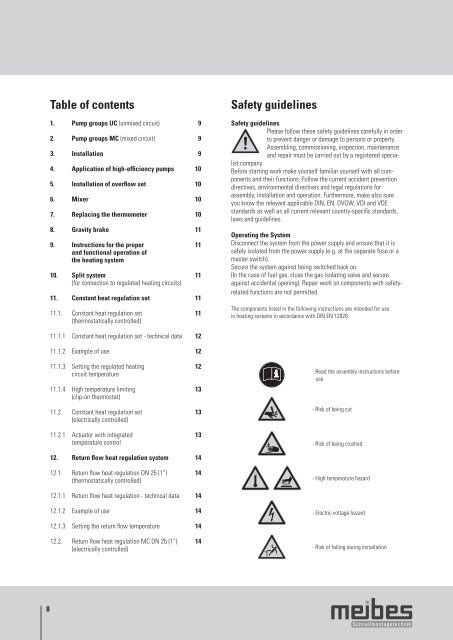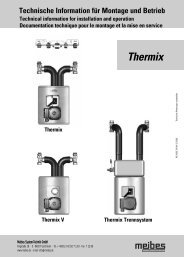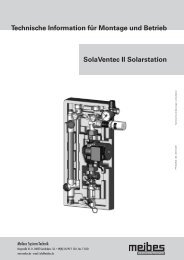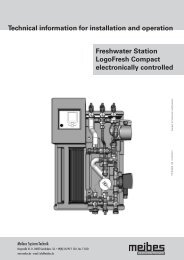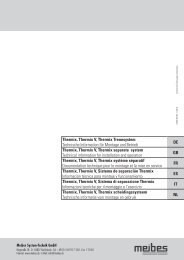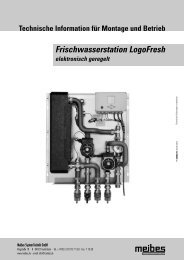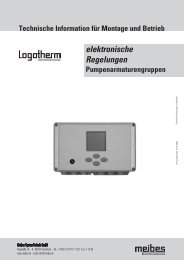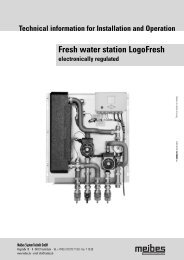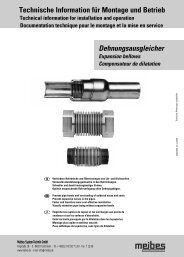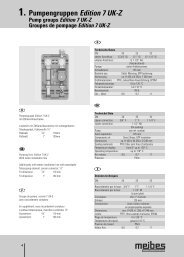2. Pumpengruppen MK - Meibes
2. Pumpengruppen MK - Meibes
2. Pumpengruppen MK - Meibes
You also want an ePaper? Increase the reach of your titles
YUMPU automatically turns print PDFs into web optimized ePapers that Google loves.
8<br />
Table of contents<br />
1. Pump groups UC (unmixed circuit) 9<br />
<strong>2.</strong> Pump groups MC (mixed circuit) 9<br />
3. Installation 9<br />
4. Application of high-efficiency pumps 10<br />
5. Installation of overflow set 10<br />
6. Mixer 10<br />
7. Replacing the thermometer 10<br />
8. Gravity brake 11<br />
9. Instructions for the proper 11<br />
and functional operation of<br />
the heating system<br />
10. Split system 11<br />
(for connection to regulated heating circuits)<br />
11. Constant heat regulation set 11<br />
11.1. Constant heat regulation set 11<br />
(thermostatically controlled)<br />
11.1.1 Constant heat regulation set - technical data 12<br />
11.1.2 Example of use 12<br />
11.1.3 Setting the regulated heating 12<br />
circuit temperature<br />
11.1.4 High temperature limiting 13<br />
(clip-on thermostat)<br />
11.<strong>2.</strong> Constant heat regulation set 13<br />
(electrically controlled)<br />
11.<strong>2.</strong>1 Actuator with integrated 13<br />
temperature control<br />
1<strong>2.</strong> Return flow heat regulation system 14<br />
1<strong>2.</strong>1. Return flow heat regulation DN 25 (1”) 14<br />
(thermostatically controlled)<br />
1<strong>2.</strong>1.1 Return flow heat regulation - technical data 14<br />
1<strong>2.</strong>1.2 Example of use 14<br />
1<strong>2.</strong>1.3 Setting the return flow temperature 14<br />
1<strong>2.</strong><strong>2.</strong> Return flow heat regulation MC DN 25 (1”) 14<br />
(electrically controlled)<br />
Safety guidelines<br />
Safety guidelines<br />
Please follow these safety guidelines carefully in order<br />
to prevent danger or damage to persons or property.<br />
Assembling, commissioning, inspection, maintenance<br />
and repair must be carried out by a registered specialist<br />
company.<br />
Before starting work make yourself familiar yourself with all components<br />
and their functions. Follow the current accident prevention<br />
directives, environmental directives and legal regulations for<br />
assembly, installation and operation. Furthermore, make also sure<br />
you know the relevant applicable DIN, EN, DVGW, VDI and VDE<br />
standards as well as all current relevant country-specific standards,<br />
laws and guidelines.<br />
Operating the System<br />
Disconnect the system from the power supply and ensure that it is<br />
safely isolated from the power supply (e.g. at the separate fuse or a<br />
master switch).<br />
Secure the system against being switched back on.<br />
(In the case of fuel gas, close the gas isolating valve and secure<br />
against accidental opening). Repair work on components with safetyrelated<br />
functions are not permitted.<br />
The components listed in the following instructions are intended for use<br />
in heating systems in accordance with DIN EN 12828.<br />
- Read the assembly instructions before<br />
use<br />
- Risk of being cut<br />
- Risk of being crushed<br />
- High temperature hazard<br />
- Electric voltage hazard<br />
- Risk of falling during installation


